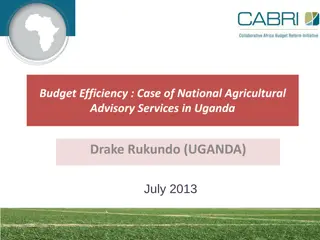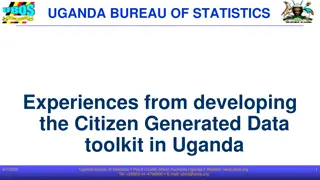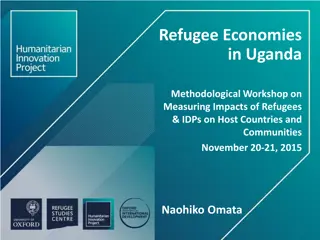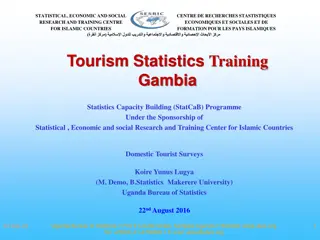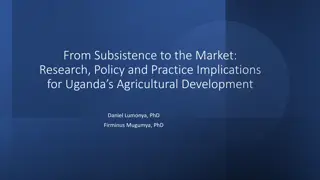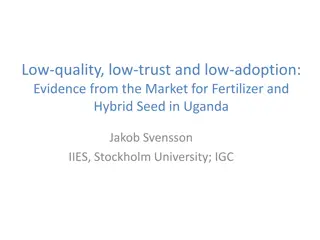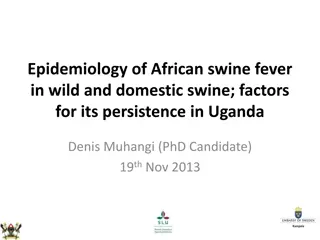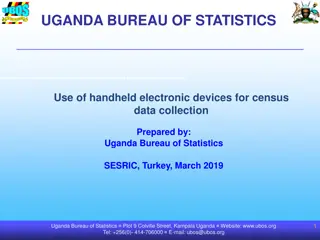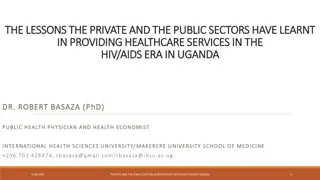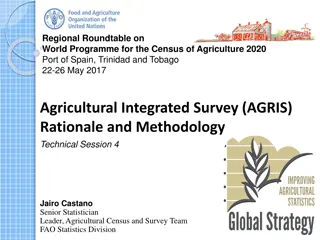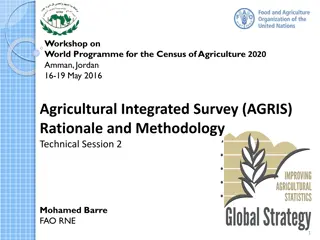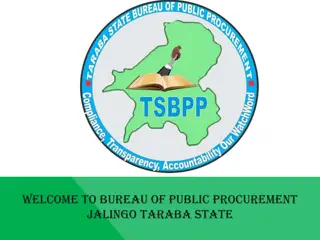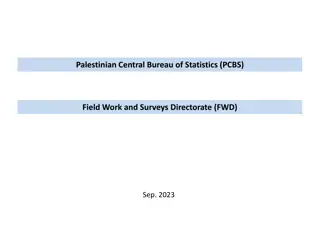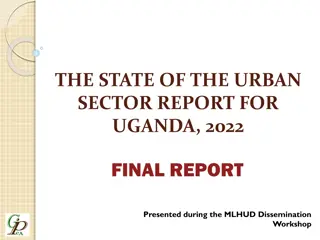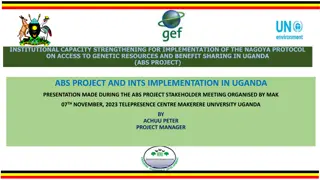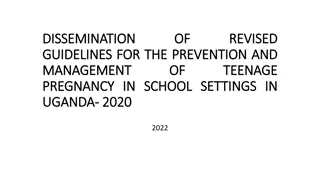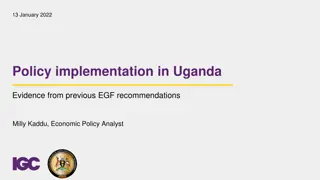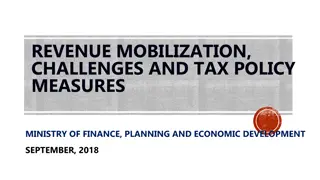Uganda Bureau of Statistics Annual Agricultural Survey 2019 Key Findings
The Uganda Bureau of Statistics (UBOS) conducts an Annual Agricultural Survey (AAS) in collaboration with the Ministry of Agriculture to provide crucial data on agricultural production, land area, prices, market information, and technology adoption. The agriculture sector in Uganda is a significant source of livelihood, contributing to GDP and employment. The AAS serves as a tool for monitoring progress, informing policy-making, and assessing the impact of government programs on agriculture.
Download Presentation

Please find below an Image/Link to download the presentation.
The content on the website is provided AS IS for your information and personal use only. It may not be sold, licensed, or shared on other websites without obtaining consent from the author. Download presentation by click this link. If you encounter any issues during the download, it is possible that the publisher has removed the file from their server.
E N D
Presentation Transcript
Uganda Bureau of Statistics Annual Agricultural Survey 2019 Key Findings Ronald Ssombwe Principal Statistician Agriculture and Environment Statistics
Uganda Bureau of Statistics Overview of the AAS
Introduction The Bureau. The Uganda Bureau of Statistics (UBOS) is a semi-autonomous body created by the Uganda Bureau of Statistics Act No. 12, 1998. UBOS is the principal data collection, processing , analyzing and dissemination agency in the National Statistical System(NSS). Our Mission. To coordinate the NSS and provide quality statistics and statistical services that support development programs. UBOS Strategic goals. a. Strengthened development and production of quality statistics. b. Enhanced coordination, cooperation and Partnerships in statistical production and management. c. Increased use of statistics for development results.
Background Agriculture is a source of livelihood to the majority of Households in Uganda and an effective mechanism for growth of other sectors(NDP) About 80% of households are engaged in agriculture-Census 2014. About 47% of Households in urban and 92% in the rural are engaged Agriculture About 39% of the working population are subsistence farmers Agriculture sector contributed 24.0% to overall GDP at current prices in 2019/20 The sector recorded a growth rate of 4.8% in 2019/20 Accounts for 36% of employment in Uganda. The focus of Vision 2040 is a transformed Ugandan society from a Peasant to a modern and prosperous country within 30 years.
Introduction The Annual Agricultural Survey(AAS) Starting in 2017, the AAS is conducted under the mandate of UBOS with collaboration of the Ministry of Agriculture Animal Industry and Fisheries(MAAIF) and support from the UN Food and Agricultural Organisation(FAO). Overall objective To provide high quality agricultural data on priority core macro and micro development indicators on the performance of Agriculture Sector in inter-censual periods. Indicators on crop, livestock and environment interaction inform various development frameworks for better policy making. Thus, the AAS was established to provide key agricultural sector indicators to monitor progress on the NDP and assess the impact of governmental programs.
Introduction Specific objectives To provide data and information on: I. Agricultural production, agricultural land area, prices of agricultural outputs and inputs, market information, farm income, food security, gender and environment; G II. adoption of agricultural production practices in different agro ecological zones in Uganda and; III. adoption and use agricultural production technologies.
Geographical Scope and Coverage All districts of Uganda grouped by ZARDI and by Statistical Sub-region G Zonal Agricultural Research and Development Institute ( ZARDIs) have same climate, land use and cropping patterns
Variable Scope The survey covered Crop and livestock farming households and collected data on various structural characteristics of the agricultural holding such as: I. II. III. Demographic and social characteristics IV. Agricultural Inputs and related costs; labour, fertilizers, etc V. Crop area and production/harvest VI. Prices for agricultural Products VII. Household food security and related shocks VIII. Agricultural services Size of holding and number of parcels/plots Land tenure systems
Other variables covered Sources of agricultural Information Access to facilities for agriculture Means of transport Storage facilities Access to credit Extension Services Land Disputes Fixed costs incurred in the ag year Farmers Training
Survey methodology The survey followed a centralized administration approach The dates of data collection were as follows: Season One Post-Planting: Start: 15th June 2019 End: 28th August 2019 Post-Harvest: Start: 16th September 2019 End: 30th November 2019
Survey methodology - ctd Season Two Post-Planting: Start: 1st December 2019 End: 31st March 2020 Post-Harvest: Start: 5th March 2020- interrupted by Covid-19 lockdown Re-Start: 6th August 2020 End: 18th October 2020 The mode used for data collection was the Computer Assisted Personal Interview (CAPI).
Sampling design Frame based on the 2014 National Popn & Housing Census A two-stage stratified sampling design was adopted. Sampling frame was divided into 10 Zonal Agricultural Research and Development Institutes (ZARDI) or 14 Statistical Sub-regions; excluding Kampala A sample of 593 EAs and an average of 12 Ag HHs were selected from each EA. About 7,000 Agricultural Households were involved in the 2019 AAS.
Data management Enumerators visited the respondents in four trips during the agricultural year. Used face-to-face interviews and captured data using CAPI . Measured agricultural land area using GPS device. Team leaders electronically reviewed data to ensure consistency. Supervisors from Head office conducted monitoring of field activities Data stored in the cloud with a local backup. Editing , validation and tabulation was done electronically using STATA Analysis and the chapters of the report were done by selected subject experts
Implementation: Achievements & Challenges Achievements Challenges 1. Since its establishment, AAS collected data for the ag years 2017, 2018, 2019, 2020 1. Intermittent delays in funding 2. High non-response rates, due to several factors, migration, etc 2. Improvement in the CAPI platform and equipment renewal 3. Coverage of Institutional & Private Large Scale farms 3. Survey instruments updated and constantly improved based on enumerators feedback 4. Intensive data collection programme. Thus, limited time for data processing and analysis 4. First survey report launched in June 2020. Second report is under preparation 5. COVID-19 caused field work delays in the AAS 2019 and obliged to redesign the AAS 2021
Structure of the 2019 AAS report The report comprises the following eight chapters: 1. Introduction, 2. Agricultural Households and Holding characteristics 3. Agricultural land 4. Agricultural practices and Inputs 5. Agricultural Services 6. Household Food Security 7. Crop Production



